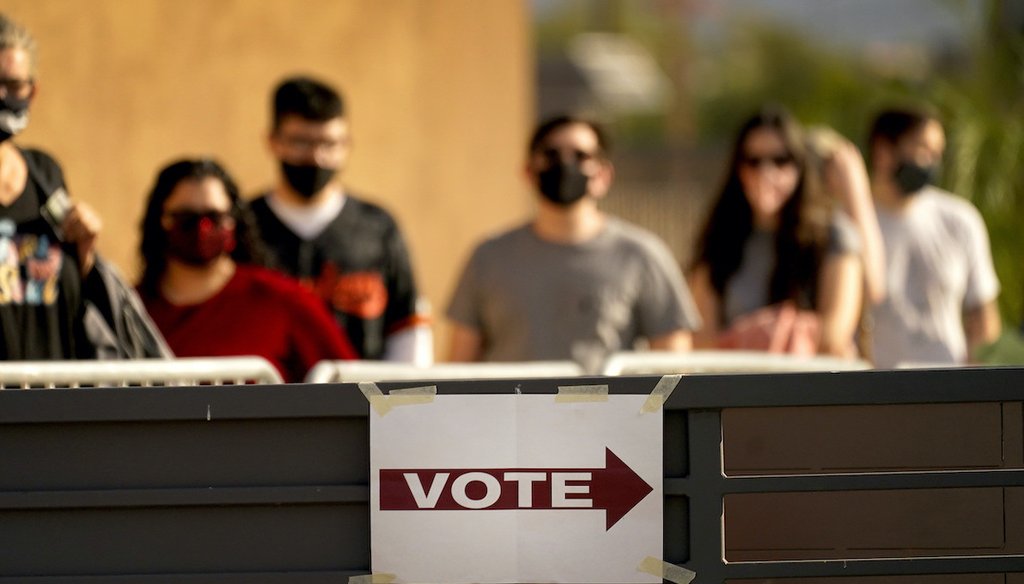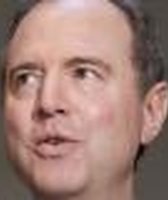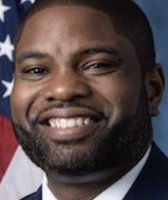Stand up for the facts!
Our only agenda is to publish the truth so you can be an informed participant in democracy.
We need your help.
I would like to contribute

In this Tuesday, Nov. 3, 2020 file photo, Voters stand in line outside a polling station, on Election Day in Mesa, Ariz.
If Your Time is short
-
Many states eased rules on voting by mail for the 2020 general election due to the COVID-19 pandemic.
-
State election laws are only one factor that can influence turnout. Other factors include how excited the public feels about various candidates on the ballot.
-
It’s too soon to know the impact of new restrictive laws passed by Republican state lawmakers following the 2020 election. State lawmakers are again considering restrictive measures this year that could be in place for the midterms.
Ted Nugent, the musician and outspoken supporter of Second Amendment gun rights (and critic of Democrats), has been clear that he believes former President Donald Trump won the 2020 election, despite all evidence to the contrary.
But in a recent meme shared on Nugent’s Facebook page, the "Cat Scratch Fever" rocker asserted that voter suppression just can’t be real — and he used Joe Biden’s record-breaking election to the 2020 presidency as proof.
"If this guy received the most votes in history, in the largest voter turnout in history like they claim, then how is the vote being suppressed like they claim?" Nugent’s Jan. 23 post said.
This post was flagged as part of Facebook’s efforts to combat false news and misinformation on its News Feed. (Read more about our partnership with Facebook.)
On its face, the question is worth considering. In reality, it’s a false dichotomy. Nugent’s post presents readers with an erroneous limit on the range of outcomes in elections.
Sign up for PolitiFact texts
Put plainly, it’s possible to have more raw votes and voter suppression at the same time.
Voter turnout fluctuates but 2020 stood apart
Nugent’s post is alluding to concerns by Democrats that Republican efforts to restrict voting options in states will end up suppressing votes.
But his logic lacks backing by credible research. The 2020 general election did draw a record turnout and Biden was elected by more votes than any other president in history, but researchers say those things happened in part due to extraordinary circumstances that included a pandemic and wide interest in the election.
Turnout was boosted by easier access to voting by mail and greater outreach by election officials on how to safely cast ballots amid the pandemic, experts say. Also clearly in the mix: voters’ strong feelings about Trump — both for and against — and what one poll showed was a higher than usual conviction prior to the election that "it really mattered" who won.
With state lawmakers taking steps now to restrict some of the voting options that experts say helped improve participation, we have yet to see how those new policies will play out in terms of overall ballots cast.
In the 2020 general election, using the metric of raw votes, more than 158 million Americans voted, more than ever before. Sure.
And as a percentage of the voting eligible population, the turnout rate in 2020 was higher than in any election since 1900. Biden received about 81.3 million votes, the first presidential candidate to receive more than 80 million.
But turnout itself doesn’t tell us about why millions of Americans — nearly 80 million who were eligible in 2020 — didn’t vote. And Nugent’s statement ignores that we don’t yet know how turnout may be affected by recently enacted voting restrictions, or those under consideration by state lawmakers. State election laws aren’t the only factor that affect voter turnout.
Voter turnout can fluctuate significantly between states and between elections, said Kathleen Unger, president of VoteRiders, a national organization that helps voters navigate voter ID laws.
"Voter turnout in a particular election can be affected positively or negatively by many factors including the weather, the candidates and races on the ballot, the perceived closeness of the races on the ballot, the locations and accessibility of polling places, and also by election laws," Unger said.
Election officials made it easier to cast mail ballots in 2020
In 2020, many states adopted measures to make it easier for voters to safely cast mail ballots amid the pandemic. Some states that previously required an excuse to vote absentee loosened their rules. Some sent all voters ballot applications or ballots in the mail or expanded the use of ballot drop boxes.
Tammy Patrick, senior advisor at the Democracy Fund, said more voters in 2020 received official information on their voting options.
"The 2020 election was a tremendous success, seeing more eligible Americans participating in our democracy than ever before in history, because of expansions in voting options and increases in messaging of those options to voters," Patrick said.
More than a year after the election, prosecutors and election officials have found so little evidence of voter fraud that it would not have affected the outcome. But in 2021, Republican lawmakers in multiple states passed restrictive measures, with the stated goal of preventing voter fraud.
Republicans are continuing this year to propose mail voting restrictions, despite research — including by Emory University political scientist Alan Abramowitz — that found no evidence that absentee voting favors Democratic candidates. Similarly, researchers at Stanford University found that "no-excuse absentee voting did not meaningfully change the composition of the electorate during the 2020 election. … The major effect of expanding absentee voting is to change how people vote, not whether they vote."
Mailing absentee ballots directly to voters did modestly increase turnout. However, Abramowitz said, "The main reason that turnout was so high in 2020 is that voters on both sides were very energized by the choice between Trump and Biden. Both parties also engaged in considerable registration and get out the vote efforts, especially Democrats."
Turnout was also high in the 2018 midterms – another sign that voters’ opinions of Trump inspired them to vote. (This is part of why Democrats fear that they are the underdog in the 2022 midterms without Trump on the ballot or in office.)
Looking only at turnout numbers ignores facts about election restrictions
Nugent’s statement omits that "high turnout in 2020 doesn’t tell us anything about how these new restrictions would impact turnout," Abramowitz said.
Some of these attempts at suppressing turnout of Democratic groups may not ultimately be successful. "In general when you try to make it harder for people to vote, people get the message ‘we don’t want you to vote’ it could get them more motivated to vote," Abramowitz said.
We are starting to see signs of the impact of a new restrictive law in Texas that requires voters to include numbers such as on their driver’s license, state ID or last four digits of their Social Security Number on their mail ballot application. If the number doesn’t match the number on file, the application must be rejected. Texas is holding primaries March 1, the first statewide election under the new law. Counties across Texas have reported higher than normal rejection rates for mail ballot applications. Travis County, one of the counties that includes Austin, as of Jan. 18 had denied about 27% of the absentee ballot applications it had received.
"You can’t look at turnout of previous elections before a lot of changes were made and say ‘eh there is no problem,’" said Kenneth Mayer, an expert on voting and elections at the University of Wisconsin-Madison.
But even if we look at turnout in 2020, that tells us how many people showed up to vote – not why millions of Americans didn’t.
"Total turnout tells us nothing about people who cannot vote," Mayer said.
An Ipsos poll found that the most common reasons for not casting ballots were that people were not registered to vote, were not interested in politics or didn’t like the candidates.
But some adults may not have been able to meet the requirements of some state election laws, such as strict photo ID rules, which disproportionately affect voters of color. States have increasingly moved toward strict ID laws over the past decade. A U.S. Supreme Court decision in 2013 opened the door to some states passing restrictive measures that no longer required the federal government to review new election laws to ensure that they didn’t discriminate against minority voters.
Other voters were able to meet such stricter rules, but "the fact that people are clearing these hurdles doesn't mean there aren't hurdles put in front of them," said Sean Morales-Doyle, acting director of the Democracy Program at the Brennan Center.
The Sentencing Project found in 2020 that 5.2 million Americans were banned from voting due to laws restricting voting rights for those convicted of felony-level crimes. The group found that one in 16 African Americans of voting age is disenfranchised, a rate 3.7 times greater than that of non-African Americans. Many of those felons are in Florida where the state passed a law in 2019 requiring them to pay off court fines and fees before voting.
Turnout numbers don’t shed light on efforts leading up to the 2020 presidential election to protect voter access. Civil rights groups sued Texas after the state flagged tens of thousands of voters officials said were noncitizens based on flawed data matching. A federal judge in 2019 blocked Texas from removing the voters.
And looking only at turnout numbers ignores that there were differences in turnout among racial groups.
"The top line turnout numbers do not tell the full story," said Morales-Doyle. "Yes it’s true there was record turnout in 2020. It’s also true that the gap in turnout between white voters and nonwhite voters persisted."
Our Sources
Ted Nugent, Facebook post, Jan. 23, 2022
U.S. Election Atlas, United States Presidential Election Results, 2020
Pew Research Center, Election 2020: Voters Are Highly Engaged, but Nearly Half Expect To Have Difficulties Voting, Aug. 13, 2020
University of Houston, The Texas Voter ID Law and the 2014 Election: A Study of Texas’s 23rd Congressional District, August 2015
Stanford Institute for Economic Policy Research, How did absentee voting affect the 2020 U.S. election? Dec. 22, 2021
Alan I. Abramowitz, Emory University political scientist, Sabato’s Crystal Ball, Assessing the Impact of Absentee Voting on Turnout and Democratic Vote Margin in 2020, Feb. 25, 2021
Austin American-Statesman, 'Too little, too late': Frustration plagues Travis County officials navigating new Texas elections law, Jan. 19, 2022
National Conference of State Legislatures, Absentee and Mail Voting Policies in Effect for the 2020 Election, Nov. 3, 2020
Brennan Center for Justice, Mail Voting: What Has Changed in 2020, Sept. 17, 2020
Brennan Center for Justice, Voter Suppression in 2020, Aug. 20, 2021
Brennan Center for Justice, Large Racial Turnout Gap Persisted in 2020 Election, Aug. 6, 2021
NPR, Poll: Despite Record Turnout, 80 Million Americans Didn't Vote. Here's Why, Dec. 15, 2020
PolitiFact, Record turnouts after voter ID law passed? Not really, March 19, 2021
Email interview, Kathleen Unger, president of VoteRiders, Jan. 24, 2022
Email interview, Tammy Patrick, senior advisor to the elections program at Democracy Fund, Jan. 24, 2022
Email interview with Alan Abramowitz, Emory University political scientist, Jan. 24, 2022
Email interview with Michael McDonald, University of Florida political scientist, Jan. 24, 2022
Telephone interview, Kenneth Mayer, University of Wisconsin-Madison political scientist, Jan. 24, 2022
Telephone interview, Sean Morales-Doyle, acting director in the Democracy Program at the Brennan Center for Justice, Jan. 26, 2022




































